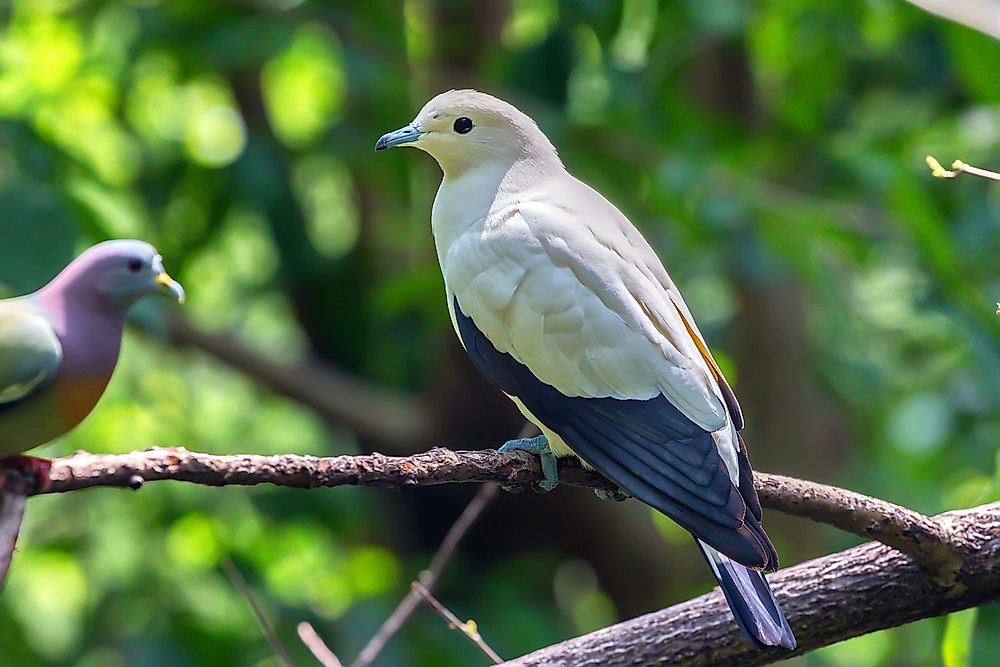The Eleven Species Of Pigeons And Doves That Are On The Brink Of Extinction

The Columbidae family features doves and pigeons classified into 42 genera and 310 species. Several species of the family are threatened including eleven critically endangered species. These eleven species are mentioned below:
11. Polynesian Ground Dove -
The Alopecoenas erythropterus is endemic to some islands of French Polynesia. It has been extirpated from most of its historical range and current population estimates suggest there are only about 100 to 120 birds left in the wild. Habitat loss and predation by cats, dogs, and other introduced species are the biggest threats to the survival of this species. Efforts are being made to conserve the species by the removal of predators and habitat restoration.
10. Purple-winged Ground Dove -
Another critically endangered species of the Columbidae family, the Claravis geoffroyi lives in the Atlantic forest of South America. The bird is primarily found in the bamboo ecosystems in parts of Brazil, Argentina, and Paraguay. The species has been severely exploited for the wild bird trade. Habitat loss is also responsible for driving the species to the brink of extinction. The wild population of this species is currently estimated at around 50 to 249 individuals.
9. Blue-eyed Ground Dove -
The Columbina cyanopis is endemic to Brazil’s Cerrado region where its natural habitat includes dry lowland grasslands. The biggest threat to this species is habitat destruction and degradation. The species was considered to be extinct since 1941 by the researchers due to zero sightings in the wild but in 2016, twelve birds were witnessed in a small area of the Cerrado leading to the re-classification of the species as critically endangered.
8. Silvery Pigeon -
The gray wood-pigeon or the Columba argentina is found in Malaysia and Indonesia. The population of this species is estimated to be just around 50 mature individuals. At a point in time, it was considered to be extinct in the wild but a few reported sightings allowed its classification as a critically endangered species. The reason for such a sharp decline in the population of this bird is yet to be explained. Habitat destruction and predation by introduced species are believed to be partly responsible for such a state of the silvery pigeon.
7. Tooth-billed Pigeon -
The Didunculus strigirostris is a large species of pigeon that is endemic to Samoa where it is the national bird of the nation. Little is known about this bird’s ecology and biology but it has been reported to exist in restricted numbers in the undisturbed forests of the country. Hunting, habitat loss, restricted range, cyclones, and introduced predators are all factors responsible for the sharp decline in the population of the tooth-billed pigeon.
6. Negros Bleeding-heart -
The Gallicolumba keayi is endemic to the Philippines. Here, the bird occurs on the two islands of Panay and Negros and inhabits both primary and secondary forests of the region. The Negros Bleeding-heart has severely fragmented populations due to massive habitat loss. The species is also hunted indiscriminately for human consumption.
5. Sulu Bleeding-heart -
Another one of the critically endangered members of the Columbidae family, the Gallicolumba menagei is found only in the Tawi-Tawi island and the islets surrounding it in the Philippines. These birds inhabit primary and secondary forests with a closed canopy. Although accurate estimations of the numbers of this species do not exist, it is believed that most of the surviving populations would be extremely small. Indiscriminate hunting and habitat loss continue to threaten the survival of these birds. Most of the forests of the Tawi-Tawi island have been cleared for human needs and no protected areas in the range of the species exists. Thus, it is highly likely that the Sulu bleeding-heart would soon become extinct.
4. Mindoro Bleeding-heart -
Native to the Philippines, the Gallicolumba platenae is also one of the world’s most threatened avian species. The bird is found only on the island of Mindoro. A type of ground dove, the species suffers from a range of threats including habitat loss, hunting for human consumption, and predation by feral cats and dogs.
3. Grenada Dove -
The Leptotila wellsi is endemic to the Lesser Antilles island of Grenada. The bird is Grenada’s national bird and one of the most threatened species of the Columbidae family. Little has been studied about this species but researchers claim that there might be less than 100 individuals of the species surviving in the wild today. Habitat fragmentation is regarded as the biggest threat to this species. Habitat degradation and fragmentation are induced by overgrazing of livestock, firewood harvesting, land development, etc. The introduction of predatory exotic species to Grenada also led to high rates of predation of the Grenada dove by these species.
2. Negros Fruit Dove -
The Ptilinopus arcanus is a species of Columbidae that is found only in the Negros island of the Philippines. Very little is known about this species and only a single female specimen discovered in 1953 in Mount Kanlaon has been studied to date. Although no confirmed sightings of the species exist after its first discovery, reports by a hunter who claims to have shot the bird in the nineties and the discovery of some species of Negros island on the nearby Panay island have raised the hope that the Negros fruit dove might still survive in the wild. Thus, it is still not labeled as extinct but categorized as critically endangered. Researchers believe that even if the bird survives today, populations would not cross fifty in number and would be threatened by hunting and habitat loss.
1. Cebu Brown Dove -
The Phapitreron frontalis is endemic to the island of Cebu in the Philippines. Although the species was believed to be extinct since 1892, scattered reports of the sightings of the bird between 2007 and 2012 allowed for its classification as a critically endangered species. Habitat loss is the biggest threat to the survival of this species.











